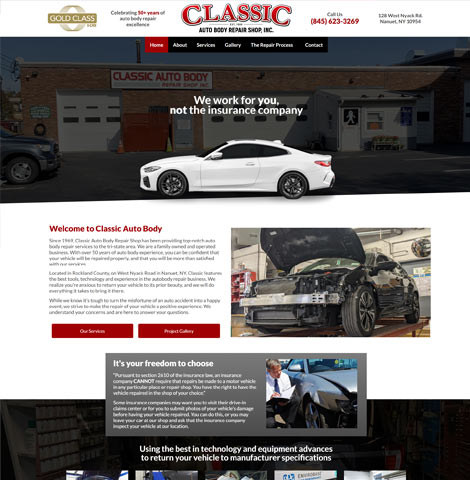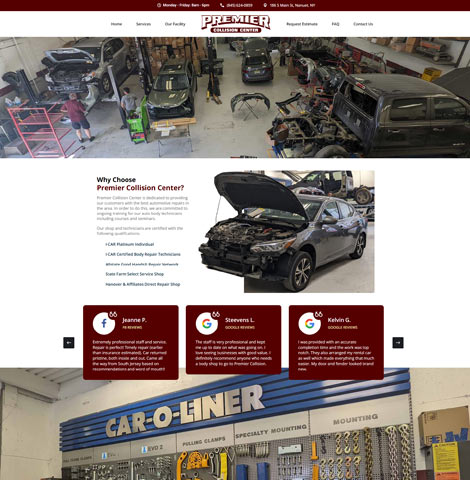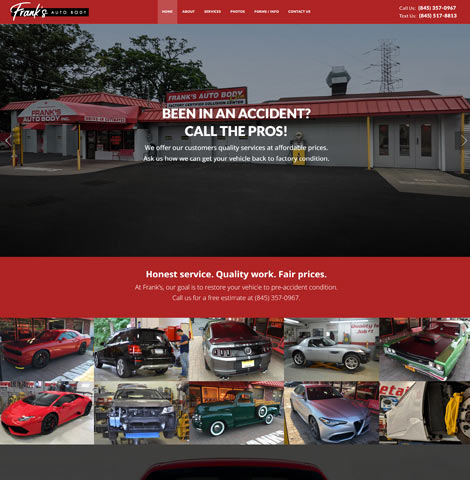If your auto body shop’s website isn’t bringing in customers, you’re not alone. Many collision repair shops struggle with ineffective websites that drive visitors away instead of converting them. Here’s why your current site might be losing you business and what to do about it.
1. Poor User Experience (UX)
Cluttered layouts, hard to read fonts, or broken links frustrate visitors. If users can’t find what they want quickly, they leave and likely go to a competitor.
When a potential customer lands on a site that’s visually overwhelming or difficult to navigate, the frustration sets in quickly. For example, a visitor who just had a car accident is likely stressed and needs answers fast. If they’re greeted with a cluttered homepage, inconsistent fonts, and menus that don’t make sense, they’ll simply exit and search for another collision shop with a more user-friendly site.
Even something as simple as a slow loading page or poor spacing between elements can cause people to feel lost or unwelcome. The experience of interacting with a website is often the first impression a customer has of a business and in many cases, it becomes the deciding factor in whether they move forward or not.
2. Lack of Mobile Optimization
With over half of internet traffic on mobile devices, an unresponsive website alienates a large audience. A mobile-friendly site is no longer optional; it’s essential.
Picture someone standing beside their damaged vehicle, searching for nearby collision repair shops on their phone. If they find your website but it loads poorly, elements overlap, text is too small to read, or buttons can’t be clicked easily, they’ll back out almost immediately. This isn’t just about preference it’s about accessibility.
Websites that don’t adapt well to smaller screens essentially cut off a major segment of potential customers. Whether it’s trying to zoom in to read a phone number or struggling to open a menu, these frustrations create roadblocks that cost you business. A non-mobile-friendly website is often seen as outdated or less professional, which can directly affect a customer’s confidence in your services.
3. No Clear Call to Action (CTA)
Does your site tell visitors what to do next? Without clear CTAs like “Request an Estimate” or “Book an Appointment,” customers won’t know how to engage with you.
A visitor may be interested in your services but have no idea how to take the next step. If there’s no standout messaging that guides them forward whether it’s scheduling, contacting, or submitting photos of their vehicle they’re left confused. In many cases, people don’t want to scroll endlessly to find contact options.
Without that push in the right direction, the decision-making process stalls. Some users might even assume the business is too busy or not accepting new clients. Clear, specific calls to action act as signposts that move a user from browsing to booking, and without them, the path forward remains unclear.
4. Missing Online Scheduling & Quotes
Shoppers expect convenience. If they can’t schedule appointments or get estimates online, they’ll move on to shops that offer these features.
Modern customers are used to doing everything online from booking haircuts to ordering groceries. So when they visit a collision repair website, they expect a similar level of convenience. Without the ability to request a quote or schedule an appointment online, potential customers may feel like your business is harder to work with compared to others.
Even during non-business hours, many people try to handle these tasks. If a visitor reaches your website at 10 PM looking to schedule, and there’s no option to do so, they’re likely to leave and find a shop that does allow it. The absence of online scheduling is often interpreted as outdated or inconvenient a major dealbreaker for today’s fast-moving consumer.
5. Outdated Design and Content
An old-fashioned website looks untrustworthy and signals that your business may be behind the times. Fresh, modern design and up-to-date information build confidence.
When people see an outdated layout, blurry images, or content that hasn’t been updated in years, they immediately question the quality of the business. An old website creates a perception that the business doesn’t keep up with technology or industry standards. For example, a site mentioning outdated vehicle models or promotions from years ago might make visitors wonder whether the business is even still open.
Even minor things like old copyright dates in the footer or broken social media links can raise red flags. Customers want to know that they’re dealing with professionals who are actively engaged and current in their field and your website is a key signal of that.
6. No Proof of Quality Work
If you don’t showcase before-and-after photos, customer testimonials, or certifications, visitors may doubt your expertise.
Trust is everything when someone is handing over their car for repairs. Without visual evidence or validation from others, visitors are left to guess at your quality. For example, a gallery of transformations from damaged to fully restored vehicles can do more to convince someone than any text description ever could.
Similarly, reading actual customer reviews especially if they mention fast service or satisfaction with the results provides a form of social proof that builds credibility. In industries like auto body repair, where results matter, showing your work and sharing your reputation is essential to earning new business.
7. Slow Website Speed
A sluggish site kills conversions. Every second counts slow load times frustrate users and increase bounce rates.
Website speed isn’t just a technical detail it’s a critical part of user perception. If a visitor has to wait several seconds for a page to load, they may interpret the delay as unprofessional or even question the business’s attention to detail. Studies show that even a one-second delay in page load time can significantly reduce engagement.
In competitive markets, customers won’t wait they’ll leave and go to the next shop on the list. And if the slow speed happens on mobile, the bounce rate becomes even higher. The digital world is fast-paced, and users expect quick access to information. A slow website feels like a closed door.
Conclusion
Your website is often the first impression customers get of your collision repair shop. If it’s slow, confusing, outdated, or lacks clear calls to action, you’re likely losing business to competitors with stronger online presence. A well-structured, mobile-friendly, and trust-building website isn’t just a bonus it’s a necessity in today’s digital-first world. By understanding what drives visitors away, you can take the first step toward making your site a tool that works for your business, not against it.





